
Steelers president Art Rooney II, Hall of Famer LC Greenwood, wide receiver Hines Ward and Steelers chairman Dan Rooney sat in the Great Hall at Heinz Field for the announcement of the 33-man all-time team, Oct. 24, 2007.
Chaz Palla/TRIBUNE-REVIEW
By Mike Prisuta
PITTSBURGH TRIBUNE-REVIEW
Thursday, October 25, 2007
L.C. Greenwood never envisioned a 75th season celebration when he was drafted by the Steelers out of Arkansas AM&N in the 10th round in 1969.
"I can remember we couldn't give away tickets," Greenwood said. "I mean, seriously, I tried to give somebody tickets and they said, 'No, I don't want to go to the game.'"
Almost 40 years and five Super Bowl championships later tickets are difficult to come by and the Steelers can't seem to stop celebrating their championship heritage.
Their latest self-tribute took place Wednesday afternoon at Heinz Field with the unveiling of the franchise's All-Time Team.
Greenwood, a defensive end from 1969-81, was one of 33 players selected through a vote of Steelers fans.
Results of the fan balloting were not made available by the Steelers.
"It's a heck of a turnaround over a number of years," Greenwood said. "To see it evolve like this is just tremendously great."
Greenwood was one of 15 players who earned four Super Bowl rings with the Steelers in the 1970s to be included on the All-Time Team, comprised of 33 players in recognition of the Steelers' inaugural season, 1933.
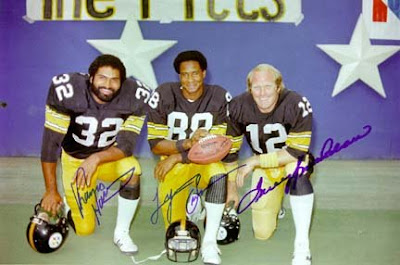
The team includes 10 members of the Pro Football Hall of Fame and 68 Super Bowl rings won with the Steelers.
Tight end Elbie Nickel (1947-57) was the most historic of the bunch.
Four current Steelers -- guard Alan Faneca, nose tackle Casey Hampton, strong safety Troy Polamalu and wide receiver Hines Ward -- were recognized.
"It's very overwhelming," Ward said. "There were a lot of great players that probably didn't make this team that helped contribute in many ways, especially on the Super Bowl teams in the 1970s.
"To have some current players, it's just a special feeling in our heart."
Mike Wagner, a safety on the four Super Bowl teams of the 1970s, was one such player overlooked by the fans.
"I think there are some guys that got left out," Greenwood said, declining to name names. "I can always say somebody got left out and then somebody's gonna say there's somebody on that shouldn't be on.
"It's a conversation piece."
Steelers president Art Rooney II acknowledged the subjective nature of the fan balloting.
"Sam Davis (guard, 1967-79) and Bryan Hinkle (linebacker, 1982-93) probably should be on it," Rooney II said.
"There will be more guys from this (current) team (worthy of eventual consideration). (Quarterback) Ben (Roethlisberger) will give Terry (Bradshaw) a run, hopefully, before it's all over. It'll be interesting."
Rooney's father Dan, the Steelers' chairman, noted Hall-of-Fame back Bill Dudley (1942, 1945-46) was included on the Steelers' Legends (pre-1970s) Team but left off the All-Time Team.
Another Hall-of-Fame running back, John Henry Johnson (1960-65), made the Legends Team but not the All-Time squad.
"We're not doing it to try to show off or anything like that," Dan Rooney said. "It's more from the standpoint of making everybody feel great about it."
The Steelers' All-Time Team will be honored Nov. 4 at the David L. Lawrence Convention Center and at the Steelers' Nov. 5 game against Baltimore.
"I think it really comes back to our fans and how much they enjoy Steelers football," Rooney II said. "The biggest part of it was to be able to bring back some memories."
The following is the team:
QB: Terry Bradshaw
RB: Franco Harris, Rocky Bleier, Jerome Bettis
TE: Bennie Cunningham, Elbie Nickel
WR: Lynn Swann, John Stallworth, Hines Ward
OL: Larry Brown, Dermontti Dawson, Alan Faneca, Tunch Ilkin, Jon Kolb, Mike Webster
PK: Gary Anderson
DL: Joe Greene, L.C. Greenwood, Casey Hampton, Ernie Stautner, Dwight White
LB: Jack Ham, Jack Lambert, Greg Lloyd, Joey Porter, Andy Russell
DB: Mel Blount, Jack Butler, Carnell Lake, Troy Polamalu, Donnie Shell, Rod Woodson
P: Bobby Walden
"We have had so many great players over the years, including before we won Super Bowls," Dan Rooney said in a statement. "The accomplishments of each of these players have played a key role in contributing to the long-standing tradition of Steelers football."
Here is a detailed breakdown of the players selected to the all-time team:
Terry Bradshaw: Quarterback (1970-83)

Winning championships is what distinguishes the great NFL quarterbacks, and that's why Terry Bradshaw was a first-ballot Pro Football Hall of Fame inductee in 1989. The Steelers won the right to pick Bradshaw first overall in the 1970 draft because they won a coin flip with the Chicago Bears. Actually, the Bears lost because their representative called heads and the coin came up tails. While calling his own plays, Bradshaw quarterbacked the Steelers to eight division titles and four Super Bowl championships; Bradshaw was voted the MVP of Super Bowls XIII and XIV, NFL Player of the Year in 1978, and he won team MVP honors in back-to-back seasons (1977-1978). In 19 career playoff games, Bradshaw threw 30 touchdown passes, and his record as a starting quarterback in conference championship games and Super Bowls was 8-2.
Jerome Bettis: Running Back (1996-05)
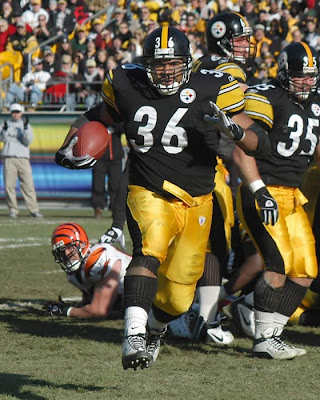
He might have been drafted into the NFL by the Los Angeles Rams, but Jerome Bettis was born to star for the Steelers. He ran the football with the type of power that energized the fans and his nimble feet allowed him to last longer and be more productive than any previous back his size. The wheels on The Bus were responsible for a lot of wins during his 10 seasons with the Steelers after arriving via a draft day trade in 1996. Bettis finished his Steelers' career with 10,571 rushing yards and 78 touchdowns, both second in team history behind Franco Harris. He also became the players' rallying point during the drive to Super Bowl XL in 2005, and Bettis was able to announce his retirement in his hometown while holding the Lombardi Trophy in his hands. He finished his career with 13,662 rushing yards to rank fifth on the NFL's all-time rushing list. A three-time team Steelers MVP, Bettis earned six trips to the Pro Bowl.
Rocky Bleier: Running Back (1968, 1970-80)

Football often is compared to war by the overly-dramatic. Rocky Bleier knows the difference. A 16th-round draft choice in 1968, Bleier also was drafted by the U.S. Army in 1969 and was wounded in combat during the Vietnam War. Bleier was awarded the Bronze Star and a Purple Heart, and then he began the arduous rehabilitation process on his foot that would enable him to return to professional football. Known primarily as a blocker for Franco Harris, Bleier finished with 3,855 yards rushing, including 1,036 in 1976. Bleier caught two touchdown passes in the playoffs, including an acrobatic one in Super Bowl XIII.
Franco Harris: Running Back (1972-83)

"We didn't win too much until he got here. And then we didn't lose very often after he did." That's what Steelers founder Art Rooney Sr. once said about Franco Harris, and that is the ultimate testament to someone who was the most productive running back in team history and one of the best big-game backs in NFL history. Harris is the Steelers' all-time leading rusher with 11,950 yards and their all-time leader in rushing touchdowns (91). Despite his star status, Harris also was the kind of player who was always hustling to the football, which put him in position for the Immaculate Reception. Harris was named Super Bowl IX MVP after rushing for a then-record 158 yards and a touchdown; in 19 playoff games, he rushed for 1,556 yards and 16 touchdowns to go along with 51 catches for 504 yards. He was inducted into the Pro Football Hall of Fame in 1990.
Bennie Cunningham: Tight End (1976-85)

When the NFL liberalized the rules in the late 1970s to benefit the passing attack, Bennie Cunningham was in the right place at the right time. Cunningham caught 202 passes for 2,879 yards with 20 touchdowns, and he earned two Super Bowl rings during his Steelers career. His best season was in 1981 when he finished with a career-high 41 receptions for 574 yards with three touchdowns.
Elbie Nickel: Tight End (1947-57)
It wasn't called tight end when he played it, but Elbie Nickel still played tight end better than anybody in Steelers' history. Nickel, drafted in the 15th round in 1947, finished his career with 329 receptions for 5,133 yards, both of which are fourth on the team's all-time lists. He also hauled in 37 career touchdowns, which is the fifth-highest total in team history. Nickel led the NFL in yards per catch with a 24.3 average in 1949, but his best season was in 1952 when he posted 55 receptions for 884 yards and nine touchdowns, all of which were Steelers' records at the time.
John Stallworth: Wide Receiver (1974-87)

It was a wet day when a bunch of scouts showed up at Alabama A&M to get a 40-yard dash time on John Stallworth. He ran poorly, but Steelers scout Bill Nunn faked an illness so as to stay behind and get another time for Stallworth, on a dry track. With all the other NFL teams having only that slow time for Stallworth, the Steelers were able to pick him in the fourth round of the 1974 draft. When he retired 14 seasons later, Stallworth had 537 catches for 8,723 yards, 25 100-yard games and 63 receiving touchdowns to rank No. 1 in team history at the time in each of those categories. He had 12 postseason touchdown catches and 17 consecutive postseason games with a reception. Stallworth set Super Bowl records for career average-per-catch (24.4 yards) and for single-game average (40.3), set in Super Bowl XIV. Stallworth was inducted into the Pro Football Hall of Fame in 2002.
Lynn Swann: Wide Receiver (1974-82)
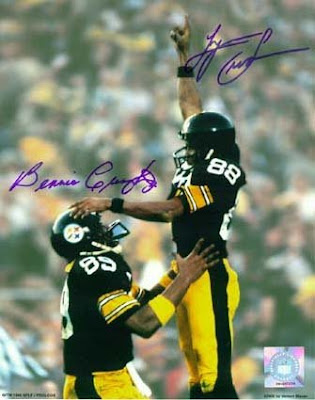
During the 1970s, professional football became a game of big plays, and Lynn Swann was a perfect fit for that style. Swann was at his best in big games, and during his career the Steelers were in 16 playoff games, and in those Swann had 48 catches for 907 yards (18.9 average) and nine touchdowns. His touchdown catch gave the Steelers the lead for good in the 1974 AFC Championship Game; he was the MVP of Super Bowl X with four catches for 161 yards and a touchdown; and he had seven catches for 154 yards and a touchdown in Super Bowl XIII. By the time his playing career ended, his surname had become synonymous with acrobatic catches -- many receivers who executed those were said to be "Swann-like." A 2001 inductee into the Pro Football Hall of Fame, Swann finished his career with 336 receptions and 5,462 yards and 51 touchdowns.
Hines Ward: Wide Receiver (1998-Present)

He'll be the first to admit that he's not the biggest or the fastest wide receiver in the NFL, but even his peers admit Hines Ward is the toughest, most physical player at his position in the game today. A third-round selection in 1998 after a career as a "slash" at the University of Georgia, Ward saw the Steelers spend No. 1 picks on receivers in both 1999 and 2000. But Ward made himself into the team's top receiver, and as the 2007 season begins he is closing in on the few team records he doesn't already hold. A four-time Pro Bowl selection, Ward is the team's all-time leader with 648 catches, and he needs 718 yards and six receiving touchdowns to pass John Stallworth for the top spots in those two categories. His 112 catches in 2002 is the team's single-season record, and he was voted MVP of Super Bowl XL.
Larry Brown: Offensive Tackle (1971-84)
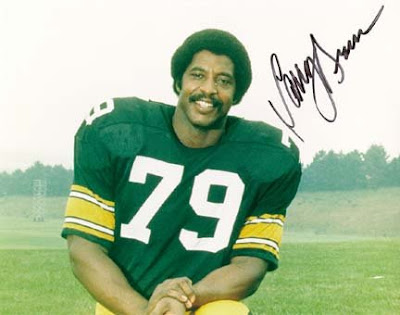
It almost seems to be a commentary on what Chuck Noll thought of both positions. The move of Larry Brown from tight end to offensive tackle showed what attributes Noll valued from the guys who played both positions. He wanted tight ends who could block, and tackles who were athletic. Brown played 14 seasons here, the first seven at tight end and the last seven as a starting right tackle. Franco Harris ran for 1,000 yards in four of those seven seasons, and was 13 yards short in another. The play of the Steelers tackles (Brown and Jon Kolb) vs. the Cowboys defensive ends ("Too Tall" Jones and Harvey Martin) was a critical part of Pittsburgh's win over Dallas in Super Bowl XIII.
Dermontti Dawson: Center (1988-00)
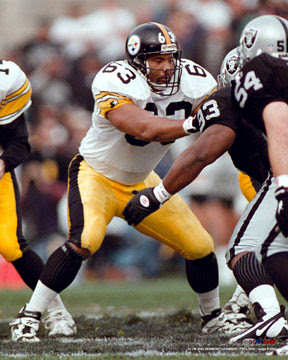
It was 1993, and the Steelers were worried about their 1992 third-round draft pick. Joel Steed had been selected to be the anchor of the defensive line as the nose tackle in the 3-4, but he was struggling. He had troubles all through his rookie training camp, then throughout that season. He was inactive for the playoff game in 1992, and his second training camp wasn't getting off to a rousing start, either. Then the Steelers traveled to Barcelona, Spain, for an American Bowl game against the San Francisco 49ers. The trip included several days of combined practices, and in those Joel Steed started to look like a player. By the end of the week, he was handling 49ers veteran center Jesse Sapolu, and that's when the Steelers figured out Steed's problem: He had been going against Dermontti Dawson every day. After eight games at guard as a rookie in 1988, Dawson won the starting center job during the following training camp and played the position for 12 of his 13 years with the Steelers. Dawson combined Mike Webster's power with an uncommon athleticism for a center, and he was named to seven straight Pro Bowls from 1992-1998. Dawson played in 171 consecutive games, until he missed a combined 16 in1999-2000 with a severe hamstring injury.
Alan Faneca: Guard (1998-Present)

During the days leading up to the 1998 NFL Draft, Jimmy Johnson was surveying the pool of talent. Then the Dolphins coach, Johnson had much draft-day success when he built the Cowboys championship teams of the early 1990s. "The guy most ready to play in the NFL," Johnson told a reporter, "is that kid Faneca from LSU." The Steelers picked Alan Faneca in the first round of the 1998 draft, and he is in the midst of a career in which he ultimately will be judged one of the best offensive linemen in franchise history. Faneca is a five-time All-Pro, and he has played in six Pro Bowls, with five starts, in his first nine seasons. In 2003, Faneca exhibited uncommon versatility by playing nine games at left tackle when injuries ravaged the line.
Tunch Ilkin: Offensive Tackle (1980-92)

Tunch Ilkin always jokes that the title of the book chronicling his career with the Pittsburgh Steelers would be: "Too Late for the Super Bowls; Too Early for Free Agency." Drafted on the sixth round in 1980 as a center from Indiana State, Ilkin became a starting tackle who played both sides of the offensive line during his 13 years with the Steelers. Ilkin played in consecutive Pro Bowls -- 1989 and 1990 -- and also was an active member of the NFLPA when it negotiated the salary cap/free agency system still in place today. Reggie White finished with 198 career NFL sacks, but he never got one against Tunch Ilkin.
Jon Kolb: Offensive Tackle (1969-81)

Professional football games of that era were won and lost on the line of scrimmage, and when Chuck Noll was hired in 1969 he quickly realized the Steelers were lacking there, on both sides of the ball. He addressed it as soon as possible, which during the pre-free agency era meant the NFL Draft. Noll picked a North Texas State defensive lineman named Joe Greene on the first round and an Oklahoma State offensive lineman named Jon Kolb in the third. Two pieces of the puzzle were in place. One of the strongest players in the NFL during his playing days, Kolb started 177 games at left tackle over the course of his 13 years, including four Super Bowls. Kolb never was voted to a Pro Bowl, but he never was out-played in a big game either.
Mike Webster: Center (1974-88)

The Steelers had just won the 1974 AFC Championship Game, and offensive line coach Dan Radakovich was grading the film of a unit that contributed to the team's 224 yards rushing. "Not a bad job, Ray," Radakovich told starting center Ray Mansfield, "but don't forget I have that rookie, Mike Webster, waiting in the wings." A guard during his first season with the Steelers after being a fifth-round draft choice from Wisconsin in 1974, Webster didn't have to wait in those wings too long -- the next year he was alternating quarters with the veteran. Webster holds the franchise records for seasons (15), games (220) and most consecutive games played (177). A seven-time All-Pro who played in nine Pro Bowls, Webster was inducted into the Pro Football Hall of Fame in 1997. But none of that happens without Dave Lechnir's dedication. Growing up on a farm in Harshaw, near Tomahawk, Wisconsin, Webster's day began with chores followed by an 18-mile bus ride to rural Rylander High School. Dave Lechnir was the school's football coach, and when he tried to get Webster to go out for football, the teenager told the coach that chores and the school bus schedule made it impossible to participate in any after-school program. Lechnir assured Webster and his father that he would drive the teenager to and from school so he could do his chores and stay late for practice. "If the coach hadn't been able to drive me, I guess I'd still be working for my dad," Webster said upon retiring from the NFL.
Joe Greene: Defensive Tackle (1969-81)

Only the truly great can change history, and that's what Joe Greene did. When Chuck Noll first met the team he inherited in 1969 he told the players that the goal was to win a Super Bowl championship but that most of them weren't good enough to be a part of that. Then, the first player Noll added to that room was Joe Greene. He'll be the first to say he's getting way too much credit, but Joe Greene's legacy to the Steelers transcends any statistics. Greene was all about the winning, and his standing among his peers in the locker room guided them in that same direction. In a 1972 game the injury-ravaged Steelers had to win to make the playoffs, Greene had five sacks and blocked a short field goal attempt by the Oilers; he recovered one fumble and forced another, and those takeaways led to two field goals in a 9-3 win. In 1974 the Steelers won their first championship, and Greene had nine sacks and an interception during the season, and then another interception and a fumble recovery in Super Bowl IX. He earned All-NFL honors five times and was voted to 10 Pro Bowls. Greene was twice the league's Defensive Player of the Year.
L.C. Greenwood: Defensive End (1969-81)
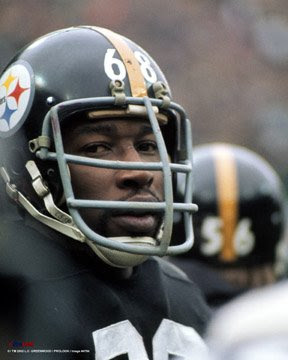
Jack Ham remembers it well, still. It was in 1976, when the Steelers defense was so dominant that it forced rules changes, and the team had a game in Kansas City. So dominant were the defensive linemen on his side of the field -- Joe Greene at left tackle and L.C. Greenwood at left end -- that he, as the left outside linebacker, went through most of the entire first half without being touched. Picked in the 10th round by the Steelers from Arkansas AM&N, Greenwood was too slight to play for many teams, but Chuck Noll and line coach Dan Radakovich nurtured his athleticism. Recognized for the gold high-top cleats he wore, Greenwood was known as a big-game player. From 1973-75 he had 25.5 sacks; in Super Bowl IX he batted down three passes; and in Super Bowl X he sacked Roger Staubach three times. He is ranked second on the team's all-time sacks list with 73.5.
Casey Hampton: Nose Tackle (2001-Present)
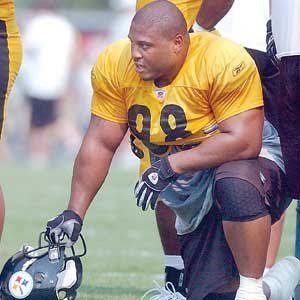
He is known throughout the NFL as a nose tackle who stops the opponent's running attack, but Casey Hampton's most memorable stop came on a different playing field. Lined up with the rest of the players and coaches on risers in the East Room of the White House, Casey Hampton stopped the President of the United States with his smile. Hampton always claimed to know George W. Bush from their days working out together at the University of Texas in the late 1990s. When the Steelers were invited to Washington, D.C., to be recognized for winning Super Bowl XL, Hampton proved it. "Hey, Hamp, how ya doin'," said Mr. Bush, who stopped to shake hands on his walk to the podium. Hampton has appeared in three Pro Bowls during a six-year career so far, and he was voted co-MVP by his teammates during the 2005 championship season.
Ernie Stautner: Defensive Tackle (1950-63)
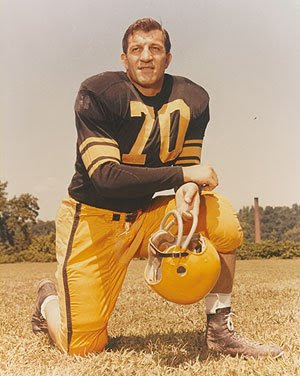
"That man ain't human. He's too strong to be human ... He's the toughest guy in the league to play against because he keeps coming head first. Swinging those forearms wears you down." That's the way Hall of Fame offensive lineman Jim Parker once described Ernie Stautner. A nine-time Pro Bowl selection, Stautner came to the Steelers as a second-round draft choice from Boston College who had been told by the New York Giants that he was too short to play professional football. But he anchored Pittsburgh's defense for 14 seasons and was voted the NFL's Best Lineman Award in 1957 because of his strength and toughness. "What made him was his strength," said Dan Rooney. "This was a time players didn't have strength, they didn't lift weights. I remember we were playing the Giants at Forbes Field one time and it was a very close game, and they were moving the ball. He sacked the quarterback three times in a row." The Steelers retired his No. 70 jersey in 1964 following his retirement, and he remains the only Steelers player to have received that honor. He was inducted into the Pro Football Hall of Fame in 1969.
Dwight White: Defensive End (1971-80)
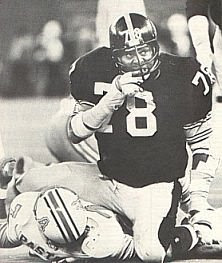
It will go down as one of the most courageous efforts on a football field in NFL history. After arriving in New Orleans a week before Super Bowl IX, Dwight White was diagnosed with severe pneumonia complicated by pleurisy, a lung infection. White spent the week in a hospital being pumped with antibiotics and losing 18 pounds, but he showed up on a wet, 46-degree day and played virtually the whole game. Seven of the Vikings' first eight running plays attacked the right side of the Steelers defense, and White made three tackles for a grand total of no yards gained. The Vikings finished with 17 yards on 21 rushing plays, and White scored the game's first points when he covered Fran Tarkenton in the end zone for a safety. Nicknamed "Mad Dog" for his intensity, White was voted to two Pro Bowls (after the 1973 and 1974 seasons), and his 46 sacks is seventh in team history. From 1972-75, White had 33.5 sacks and he capped that era with three sacks against Dallas in Super Bowl X.
Jack Ham: Outside Linebacker (1971-82)
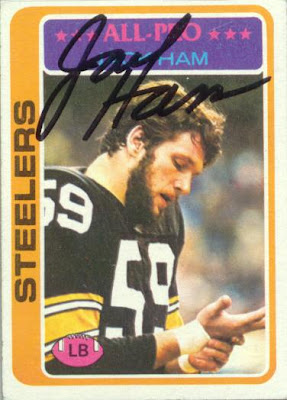
It was 1975, and the Steelers were having their way with the San Diego Chargers in the regular season opener. Protecting a big lead in a game they eventually would win, 37-0, the Steelers coaches had just told Jack Ham and Andy Russell they were through for the rest of the day, and so Ham had begun to tell Russell about the coal business he had gotten into during the offseason. In the middle of the story, the Chargers returned an interception to the 3-yard line, and with the idea of protecting the shutout Ham was sent back onto the field. Wrote Russell, "The first play the Chargers ran was a sweep to the right. Bad idea. Ham took their giant tight end, threw him aside, speared the runner behind the line of scrimmage causing him to fumble, which of course Jack recovered. As he slowly walked off the field, he casually flipped the ball to the ref. Returning to our position on the sideline, Jack turned to me smiling and said, 'Where was I?'" Ham earned All-Pro or All-AFC honors in seven consecutive seasons, played in eight straight Pro Bowls, was named the Football News Defensive Player of the Year in 1975 and was inducted into the Pro Football Hall of Fame in 1988. He also forever changed the way outside linebacker was played in the NFL.
Jack Lambert: Middle Linebacker (1974-84)

When asked for the umpteenth time by the media about a hit on Browns quarterback Brian Sipe that got him thrown out of a 1981 game, Jack Lambert said, "Brian has a chance to go out of bounds and he decides not to. He knows I'm going to hit him. And I do. History." Said teammate Andy Russell, "Tough, raw-boned, intense -- that's the way he'll be remembered, but I've seen a lot of guys like that come into the league. No, Jack's a whole lot more. The range he has -- they put him into coverage 30 yards downfield. They gave him assignments the Bears or the Packers never would've dreamed of (for Dick Butkus and Ray Nitschke). He brought a whole new concept to the position, and that's why, for me, he's the greatest there ever has been. His first step is never wrong, his techniques always have been perfect. His greatness has nothing to do with his popular image." But what an image. After Lambert threw Cliff Harris to the ground for taunting Roy Gerela after a missed field goal in Super Bowl X, Chuck Noll said, "Jack Lambert is a defender of what is right." Inducted into the Pro Football Hall of Fame in 1990 after a very productive NFL career, Lambert led the Steelers in tackles in every season except his last one, which was ruined by the toe injury that forced him to retire. He was a two-time NFL Defensive Player of the Year, eight-time All-Pro and nine-time Pro Bowl selection. Lambert was voted team MVP twice in his career.
Greg Lloyd: Outside Linebacker (1988-97)

Dick LeBeau has been involved in the National Football League for 47 years, 14 as a player and the last 33 as a coach. He has had two stints as a defensive coordinator in both Cincinnati and Pittsburgh, and he was the Bengals' head coach from 2000-02. When asked which player he has coached over those 33 seasons that he'd pick to build a defense around, LeBeau answered almost immediately: Greg Lloyd. What distinguished Lloyd from so many others? "Greg had a no-nonsense approach," said LeBeau, "that seemed to permeate the rest of the group." Lloyd played college football at Fort Valley State, where he also majored in chemical engineering, and the Steelers discovered him on a tape of the Sheridan All-Star Game, which featured players from the predominantly black colleges. Lloyd stood out because he made just about every tackle, all over the field, and the Steelers made him their sixth-round draft pick in 1987. Then, on his first play during his first minicamp, Lloyd covered the back out of the backfield and made the interception. A three-time All-Pro, Lloyd ranks sixth on the team's all-time sacks list with 53.5, played in five Pro Bowls and was named team MVP twice.
Joey Porter: Outside Linebacker (1999-2006)
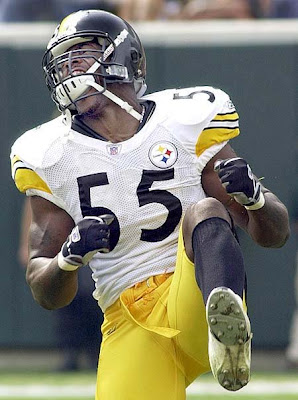
There are a lot of elements that must come together for a team to put together a run to an NFL championship, and when the Steelers were doing that in 2005, Joey Porter was invaluable. Not only did he post three sacks in the three AFC playoff games, but Porter used his personality to make sure his teammates were ready for whatever they might encounter. He called the Indianapolis Colts "soft" before the AFC Divisional Playoff game, and then he took on Seahawks tight end Jerramy Stevens during the verbal run-up to Super Bowl XL. And it was Porter who orchestrated two tributes to Jerome Bettis that week -- one with the Notre Dame replica jerseys and the other by allowing him to take the field alone during pregame introductions at Ford Field. Porter finished his eight seasons in Pittsburgh with 60 career sacks, which ranks fourth on the team's all-time list. He also had 10 interceptions and eight fumble recoveries, which he turned into four touchdowns. Porter was named the team's co-MVP in 2002 and earned three trips to the Pro Bowl.
Andy Russell: Outside Linebacker (1963, 1966-76)

Wrote Jack Ham, "Today, most players back into the Pro Bowl by playing mediocre football on good teams. Andy played great football on a worse than mediocre team. Why? Because Andy was always the consummate professional. His personal pride and drive for excellence allowed him to stand out on even the worst of football teams. It would have been easy for him to give up or be sucked into the mediocrity that he saw all around him, but he refused to do so. That attitude was clear to me from my first day of training camp to Andy's last game with the Steelers." From 1963-71, Russell played on a lot of Steelers teams that did a lot of losing, but he also was part of the dramatic turnaround that ended with back-to-back Super Bowl championships in 1974-75. Russell played in 168 consecutive games during his NFL career with the Steelers. A No. 16 draft pick from Missouri, Russell played in seven Pro Bowls and was voted team MVP in 1971.
Mel Blount: Cornerback (1970-83)
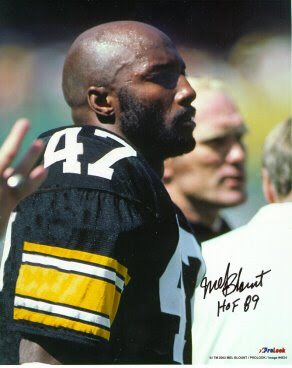
Mel Blount was walking through the bowels of Three Rivers Stadium in 1982 when he happened upon a group of scouts recording the vertical jump of the latest hot prospect. This time the prospect was Renaldo Nehemiah, the world-record holder in the 110-meter high hurdles. There was a black mark on the wall, and Blount asked what it was. When told that was Nehemiah's mark for his vertical jump, Blount, in his street clothes, promptly jumped higher and said, "That's the Steelers' mark." At the time, Mel Blount was 31 years old. That's the level of athleticism Blount, the Steelers' No. 3 pick in 1970, brought to cornerback, and he also was so big, strong and fast that he helped force the NFL to change its rules on pass defense after the 1977 season. Blount played 14 seasons and 200 games in Pittsburgh, and his 57 interceptions are tops in team history. After being pulled from the 1974 AFC Championship Game and stung by the move, Blount rebounded in 1975 to record 11 interceptions and be voted NFL Defensive Player of the Year. He played in five Pro Bowls and was named an All-Pro four times.
Jack Butler: Defensive Back (1951-59)

It is said that defensive backs often choose between making a play on the football or making a play on the receiver. Jack Butler did both. Described by former Pittsburgh Press sports editor Pat Livingston as "having the face of a choirboy and the heart of an arsonist," Butler played nine seasons with the Steelers and recorded 52 interceptions in 103 games, and the guy who once studied to become a priest accomplished that in a most uncharitable way. "The best pass defense is the respect of the receivers," said Butler. "If they know they're going to get hit as soon as they touch the ball, they're not so relaxed catching it." When Butler's stellar career ended, only Hall of Famers Dick "Night Train" Lane and Emlen Tunnell had more interceptions than him. Butler never played high school football, and only tried out at St. Bonaventure College as a lark. Father Dan Rooney, a priest at St. Bonaventure, recommended Butler to his brother, who just happened to be Art Rooney Sr., the founder of the Pittsburgh Steelers. Butler finished his career with four consecutive trips to the Pro Bowl from 1956-1959.
Carnell Lake: Safety (1989-98)

Rod Woodson had torn his ACL in the opener, and seven games into the 1995 season the Steelers were 3-4 and still hadn't found a capable replacement. Coach Bill Cowher decided the last option was to move safety Carnell Lake to cornerback, and defensive coordinator Dick LeBeau got on the telephone and informed Lake of the impending move. The next day when LeBeau arrived at Three Rivers Stadium at 6 a.m., Lake was already there waiting for the tutorial to begin. A linebacker in college, Lake made the difficult transition to safety in the NFL, and then as a professional, he twice made the even more difficult transition to cornerback, and both times he did it at midseason. Lake made four consecutive trips to the Pro Bowl, including both seasons when he switched to cornerback -- 1995 and 1997. Without Lake playing as he did in 1995, the Steelers never would have advanced to Super Bowl XXX. Also in 1997, Lake became the first defensive back in franchise history to lead the team in quarterback sacks, with six.
Troy Polamalu: Safety (2003-Present)
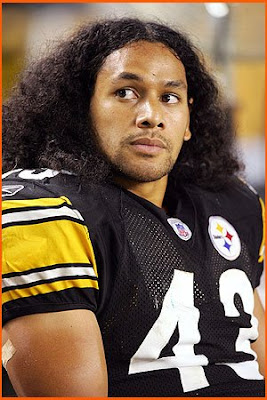
"If you don't know where Troy Polamalu is," said Patriots coach Bill Belichick, "he'll kill you." The Houston Texans got a live example during a 2005 game when Polamalu recorded three sacks, one of which came when he walked up to the line, then turned his back to the line of scrimmage in an apparent move to get back into coverage, only to pivot at the snap of the ball and find a lane to quarterback David Carr. "I mean, every time I looked up, it seemed like No. 43 was in my face," said Carr, who was sacked eight times that afternoon. The 16th overall pick of the 2003 draft, Troy Polamalu and Ed Reed are the first two players named whenever the subject is big-play safeties in the NFL. In two separate meetings with Peyton Manning and the Indianapolis Colts in 2005, Polamalu had an interception in each game, even though the one in the playoffs was ruled incomplete by referee Peter Morelli. In his four NFL seasons, Polamalu has 10 interceptions, seven sacks and two appearances in the Pro Bowl.
Donnie Shell: Safety (1974-87)
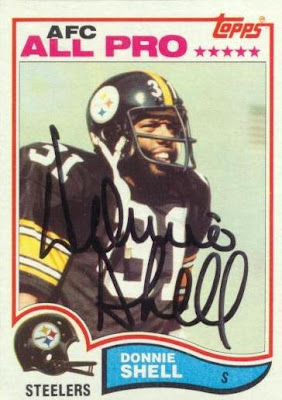
Earl Campbell was a 233-pound running back by trade, and inflicting pain was part of his business. In 1978, Campbell would finish with 1,450 yards, a 4.8 average and 13 touchdowns, but on Dec. 3 with the division title at stake, he met his match in Donnie Shell. In the first quarter, Campbell was spinning out of a tackle trying to get extra yards, when the man nicknamed "Torpedo" came flying up to the line of scrimmage and delivered a blow that could be heard in the upper reaches of the Astrodome. Campbell left the game with a broken rib, and the Steelers beat the Oilers, 13-3, in a season that ended with the third Super Bowl championship in team history. Shell was an undrafted rookie in 1974 because he played linebacker at South Carolina State, but through hard work and dedication he made himself into an All-Pro who finished his career with 51 interceptions, still the most in NFL history for a strong safety. Shell was a five-time Pro Bowl player, who had at least one interception in each of his 14 NFL seasons.
Rod Woodson: Cornerback (1987-96)
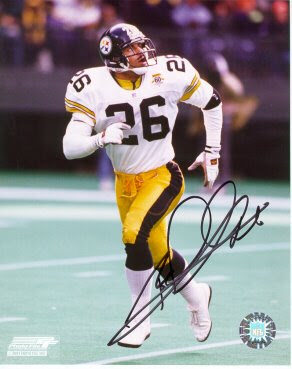
He had missed the entire 1995 regular season with a knee injury, and in the 1996 opener the Steelers lost a game and four linebackers to injury in Jacksonville. The defense was reeling, and division rival Baltimore was due at Three Rivers Stadium the next Sunday. On the second offensive play of the game, Ravens quarterback Vinny Testaverde tried to go right at Rod Woodson. Big mistake. Woodson intercepted the pass and returned it 43 yards for a touchdown to set a tone for a season that ended with another division championship in Pittsburgh. One of only five active players selected to the NFL's 75th Anniversary Team in 1994, Woodson was a six-time All-Pro cornerback during his career in Pittsburgh and was named the NFL's Defensive Player of the Year in 1993. Woodson intercepted 38 passes during his career here, and he set a team record by returning five for touchdowns. Possessing the ideal blend of speed and strength, Woodson was a world-class athlete who qualified for the 1984 Olympic trials in the 110-meter hurdles, and he also finished his Steelers career as the team's all-time leader in punt and kickoff returns. During a memorable matchup against Jerry Rice and the 49ers in 1993, Woodson intercepted Steve Young twice and blocked a 47-yard field goal in the Steelers' 24-13 loss.
Gary Anderson: Kicker (1982-94)
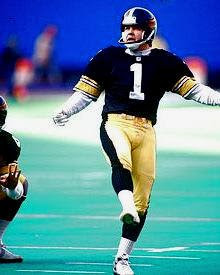
The Dallas Cowboys had won 17 straight openers when the Steelers visited there to start the 1982 season, and the game was being televised on Monday Night Football to boot. Gary Anderson was a rookie who had been cut by Buffalo and signed by the Steelers just days before that game, and he made an immediate splash in the NFL. Anderson was 3-for-3 in field goals that night, all in the second half, and the Steelers held on for a 36-28 win. The Steelers' all-time leader in points, Anderson was named to the NFL's All-Rookie team in 1982 and followed that by leading the AFC in scoring and being named team MVP the following year. Anderson connected on 309 field goals in 395 attempts (78.2 percent) and 416-of-420 PATs for a Steelers'-record 1,343 points. A three-time Pro Bowl selection, Anderson owns the team's career records for points (1,343), field goals (309), field goal attempts (395) and longest field goal (55). In a 1989 Wild Card Game in Houston, Anderson's 50-yard field goal in overtime was the difference in a 26-23 upset win for the Steelers.
Bobby Walden: Punter (1968-77)
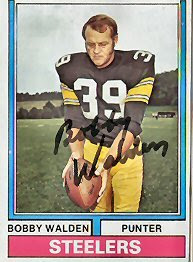
Cairo is the county seat of Grady County, Georgia, and its most famous resident is Jackie Robinson, the man who integrated Major League Baseball 60 years ago. Bobby Walden might not be that famous, but in those parts he is known as "The Big Toe from Cairo." Walden still owns the Steelers' all-time record for career punts with 716, and his 41.1-yard average puts him seventh on the team's all-time list. Walden was the team's punter on the first two Super Bowl championship teams of the 1970s.
Mike Prisuta can be reached at mprisuta@tribweb.com or 412-320-7923.
No comments:
Post a Comment